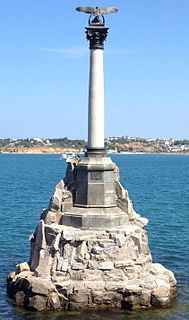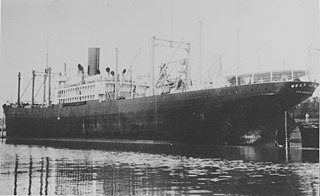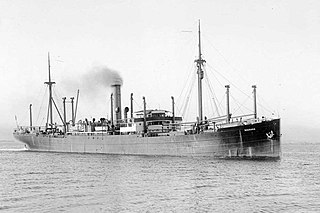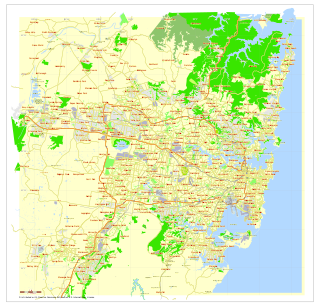This page is based on this
Wikipedia article Text is available under the
CC BY-SA 4.0 license; additional terms may apply.
Images, videos and audio are available under their respective licenses.

A shipwreck is the remains of a ship that has wrecked, which are found either beached on land or sunken to the bottom of a body of water. Shipwrecking may be deliberate or accidental. In January 1999, Angela Croome estimated that there have been about three million shipwrecks worldwide.

The United States Maritime Administration (MARAD) is an agency of the United States Department of Transportation.
Its programs promote the use of waterborne transportation and its seamless integration with other segments of the transportation system, and the viability of the U.S. merchant marine. The Maritime Administration works in many areas involving ships and shipping, shipbuilding, port operations, vessel operations, national security, environment, and safety. The Maritime Administration is also charged with maintaining the health of the merchant marine, since commercial mariners, vessels, and intermodal facilities are vital for supporting national security, and so the agency provides support and information for current mariners, extensive support for educating future mariners, and programs to educate America's young people about the vital role the maritime industry plays in the lives of all Americans.

Scuttling is the deliberate sinking of a ship by allowing water to flow into the hull.
This can be achieved in several ways—seacocks or hatches can be opened to the sea, or holes may be ripped into the hull with brute force or with explosives. Scuttling may be performed to dispose of an abandoned, old, or captured vessel; to prevent the vessel from becoming a navigation hazard; as an act of self-destruction to prevent the ship from being captured by an enemy force ; as a blockship to restrict navigation through a channel or within a harbor; to provide an artificial reef for divers and marine life; or to alter the flow of rivers.

A salvage tug is a specialized type of tugboat which is used to rescue ships which are in distress or in danger of sinking, or to salvage ships which have already sunk or run aground.

The Cockatoo Island Dockyard was a major dockyard in Sydney, Australia, based on Cockatoo Island. The dockyard was established in 1857 to maintain Royal Navy warships. It later built and repaired military and civilian ships, and played a key role in sustaining the Royal Australian Navy. The dockyard was closed in 1991, and its remnants are heritage listed as the Cockatoo Island Industrial Conservation Area.

Australian Maritime Safety Authority (AMSA) is an Australian statutory authority established in 1990 under the Australian Maritime Safety Authority Act 1990 and governed by the Commonwealth Authorities and Companies Act 1997. It is responsible for the regulation and safety oversight of Australia's shipping fleet and management of Australia's international maritime obligations. AMSA is funded largely through levies on the shipping industry. The authority has a jurisdiction over Australia's exclusive economic zone which covers an area of 11,000,000 square kilometres (4,200,000 sq mi). AMSA maintains Australia's shipping registries: the general and the international shipping registers.

The USAT Meigs was a United States Army transport ship that was built in 1921 and sunk in Darwin Harbour in the first Japanese air raid against the Australia mainland on 19 February 1942.
The Australian Hydrographic Service is the Australian Commonwealth Government agency responsible for providing hydrographic services that meet Australia's obligations under the SOLAS convention and the national interest; enabling safe navigation, maritime trade and supporting protection of the marine environment. The agency, headquartered at the Australian Hydrographic Office in Wollongong, New South Wales, is an element of the Royal Australian Navy (RAN), and serves both military and civilian functions. The names Australian Hydrographic Service and the Australian Hydrographic Office are commonly abbreviated as AHS or AHO respectively.

The Pfalz was a 6,557 ton cargo steamer operated by German shipping company Norddeutscher Lloyd. The ship became the target of the first shot fired by Australian forces in World War I, soon after departing the Port of Melbourne in Australia.

Sir Leslie Orme Wilson, was a Royal Marines officer, Conservative politician, and colonial governor. He served as Governor of Bombay from 1923 to 1926 and as Governor of Queensland from 1932 to 1946.
The Department of Shipping and Transport was an Australian government department that existed between May 1951 and December 1972.

President Taylor was a cargo—liner, ex President Polk, ex Granite State, requisitioned for war service in December 1941 and allocated by the War Shipping Administration (WSA) to the U.S. Army and operating as a troopship in the Pacific Ocean in World War II when grounded and eventually lost on 14 February 1942.

HMAS Koolonga was a 4,260 gross tons cargo ship built by Sunderland Shipbuilding Company, South Dock Sunderland, England, in 1914 and bought by McIlwraith, McEacharn Line Pty Ltd, Melbourne and named SS Koolonga. She was requisitioned by the Royal Australian Navy on 6 August 1914, as a collier and supply ship. She was returned to her owners in late 1915. She was sold in 1937 to Madrigal & Company, Philippines and renamed Paz. She was scuttled during the Second World War at Sourabaya Harbour in 1942 and was later salvaged by the Imperial Japanese and renamed Hatsu Maru. While at anchor in Manila Bay, Philippines on 13 November 1944, she was attacked by United States Navy carrier aircraft and was sunk.

HMAS Mallina was a 3,213 GRT cargo ship built by Harland & Wolff, Belfast in 1909 as Mallina for the Australian United Steam Navigation Company for the Rockhampton to Sydney cargo route. She was requisitioned by the Royal Australian Navy in 1914, as a store carrier and collier. She was returned to her owners in 1915. She was sold in 1935 to Machida Shokai Kisen Kaisha, Japan and renamed Seiko Maru, before being sold to Kita Nippon Kisen Kaisha and renamed Siberia Maru No. 3, which was later shortened to Siberian Maru. While steaming in the Sulu Sea, Philippines on 24 September 1944, she was attacked by American aircraft of Task Force 38 and sunk with the loss of 158 of the 2,382 people on board.

Tancred was a salvage rescue tugboat operated by the Royal Navy (RN) between 1943 and September 1944 before being transferred to Australia. She was broken up in 1983.
Port Line was a passenger and cargo shipping company, initially formed as the Commonwealth and Dominion Line in 1914, and in operation in one form or another until 1982.

Vice Admiral Sir William Clarkson, is regarded as the co-founder of the Royal Australian Navy (RAN), in which he served as a senior commander.

February 2017
















